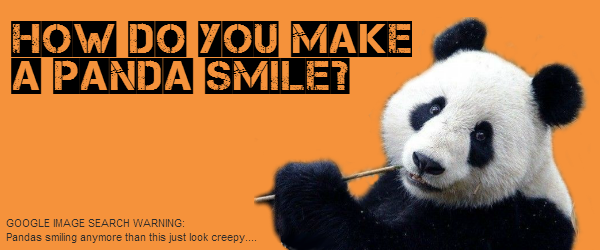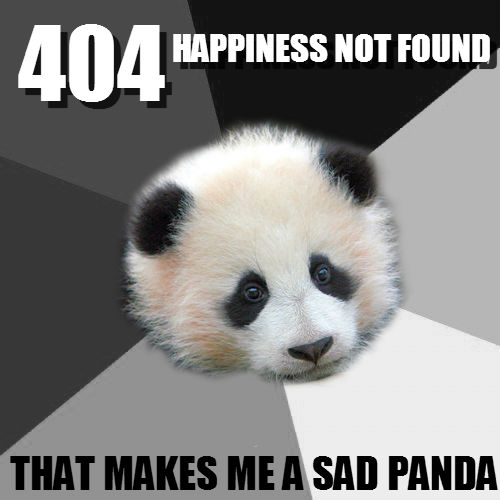
Panda 4.0 is no joke. It’s the biggest panda update to have come out since August 2011. Affecting 7.5% of English search queries, it’s also the largest Panda update to have come out since the Panda was first let out of its cage in February 2011. This is more than just a standard data refresh; this is an algorithmic update.
Google is rolling out our Panda 4.0 update starting today.
— Matt Cutts (@mattcutts) May 20, 2014
Chaos ensued.
Now that the initial Panda panic has settled a bit in the online community, it’s important to review what Google Panda is and how it affects our websites. After all, in the past it has seemed as if the smallest on-site issue can be enough to trigger the unforgiving Panda Penalty.
This ranking update certainly seems to be the cutest and cuddliest of Google’s Panda updates. The original Panda played a little too rough before and nobody really liked him. But he’s been all fluffed up now, so hopefully we’ll be seeing a cuddlier side to the Panda that we all originally came to fear. Let’s call him George!

How to avoid getting mauled to death by George!
George can be ferociously hostile to those who offend him. His target? Low quality websites. He’ll feel no remorse either. After all, he is a Panda. But what can you do to avoid the ruthless wrath of George?
As with any update, when Pandazilla first came stomping his way into town, there were cries of collateral damage. There are business owners who have struggled to get back up on their feet since the initial release of the Panda. Business owners who aren’t sure why they got knocked down in the first place, and have been trying their very hardest to make an honest comeback. Panda 4.0 hits and they’ve found that their organic traffic has shot back up again. Was their previous loss in organic traffic their mistake or Google’s? And if it was Google’s own mistake, that has now been rectified with the recent update, then it was a mistake that cost some people their jobs.

But that’s the problem when your business relies solely on Google Search, and you don’t invest enough into other sources of traffic. Yes, it’s called search engine optimisation which implies that the job role is to optimise for search engines, but that doesn’t necessitate that you give all your bamboo to one panda. There needs to be some effort made to diversify referral traffic, so that your business doesn’t get screwed over next time there’s an update and you happen to innocently be sitting cross-legged in the line of fire.
Two months ago at SMX West, Matt Cutts announced that they were working on the next generation of the Panda. One that will “soften” their algorithm. Though he didn’t specify then how soon we should be expecting it, he did state that its aim was to help small businesses who had been negatively impacted by the less merciful versions of the Panda that came before George. So far, there seems to be a huge improvement in how small businesses are ranking. Those who have played by the rules from day one are finally starting to see the benefits, with their rankings flying higher than they were previously. The search results for product-related queries in particular are no longer being dominated by eBay, as eBay have finally dropped an enormous amount in search visibility.
Did you know a Panda’s diet is over 99% SPAMBOO?

Panda eats spammy sites for breakfast. And lunch. And dinner. He just doesn’t stop eating. Trouble is, not everyone with a spammy website even knows that they have a spammy website. You could regard yourself to be 100% white hat, ridiculing the very idea of ever engaging in black hat tactics, ignorant to the fact that your over-optimisation is actually costing you. Although over-optimisation penalties are often attributed to the Penguin, on-page over-optimisation is still something to actively avoid to keep the Panda happy. Also, on that note, just because you believe you are “white hat” doesn’t necessarily mean that you are producing quality content. You could be following Google’s best practices religiously, but still lack the ability to produce good content that is of value to Google’s users.
Google’s Panda favours websites that provide real user value. They want the creamy content to rise to the top of their search cappuccino and will reward those who can deliver that content. If you really want to make the Panda smile, you have to take a look at your on-site page quality.
A few things that could cause a Sad Panda:

Duplicate content?
Duplicate content doesn’t just mean content that has been scraped from your site. (Though, of course, there are obvious issues with your work being plagiarised and displayed elsewhere without your permission, and steps need to be taken to get that content removed.) You will also need to amend any duplicate pages across your domain. Your foobar.com’s have to redirect to your www.foobar.com’s or vice versa so that there only exists one version of each page, or pages that cannot avoid being a duplicate need to be canonicalised accordingly.
Too many ads?
Google aren’t dumb. They can tell if you have way too many ads for the page to have any purpose other than to serve ads. And these types of websites are often associated with content farms. Content farms rarely ever benefit any user but the one that owns the content farm. And sometimes those chasing a backlink, but how good is a backlink when it’s coming from a spammy site?
Low dwell time?
Though a high bounce rate and a low time spent on site may mean that users find exactly what they’re looking for immediately on your page and find no other reason to stay, if users hit that back button after a short amount of time on your page, that indicates to Google that your result doesn’t answer their search query. The user is having to go back to the results to try again. Google have assured us before that they don’t use Google Analytics’ bounce rate in their ranking algorithm, but they have always been evasive when answering questions about the importance of search results CTR and dwell time. Whether or not it is used in the algorithm, either way it’s a good idea to monitor user activity on your webpage to identify which pages are strong and which are weak. Then ask yourself why.
Fresh high-quality content?
Is the content original? Is the information current and relevant? Google favours fresher content in their search results. You can read more about why Google likes fresh content here!
Those who choose to ignore Google’s warnings may see a dramatic sudden decrease in organic traffic, as Google decreases the rankings of pages that offer little to no value. It’s going to take a couple of weeks before we’ll see the results starting to stabilise, but from what we here at Silkstream have observed so far, things are going well for Matt Cutts & Gang’s ongoing spam-fighting adventures!
Expect big changes within the next couple of weeks!


